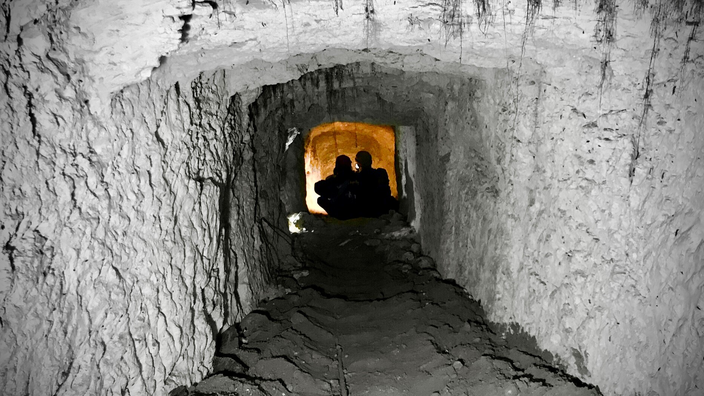It all started with a small subsidence in the forest.
In the Oise, around Moulin-sous-Touvent, the slightest hole, the slightest doubt creates doubt.
What could be mistaken in other latitudes for an ordinary recess in the earth or a vulgar burrow is considered with caution and precaution on this ancient battlefield.
This is not a capricious regionalism, but a necessity.
More than a century ago, these rural and forest lands formed the hazardous scene of a particularly explosive form of underground military operations carried out during the First World War: mine warfare.
Read alsoAisne: 550 inhabitants of a village evacuated to unearth shells from the First World War
“The goal was to simply blow up enemy lines,”
says Maximilien Hiebinger, president of the German Underground Association in Puisaleine and the surrounding area 1914-1918 (Asape 14-18). The Isarian knows what he is talking about. With the thirty of the most active members of his association, he has unearthed over the past two years five underground galleries from the First World War. That is to say a small fraction of the network which crossed this strategic sector located about fifteen kilometers west of Compiègne.
The last of these veins irrigated by black powder, hair and death, a large German mine discovered on private property in the town of Moulin-sous-Touvent, extended up to 27 meters below ground level.
Identified by its owner because of a subsidence, this gallery would be
"the deepest and most voluminous, ever carried out"
on this sector in the old front line, says the association in a press release published on September 10.
In a forest of the Oise, a German gallery abandoned in 1917 revives the memory of the mine war
Go to the slideshow (9)
Built on three levels and 122 meters long of galleries, this deep underground - numbered G24 by the German army - was explored in mid-August by Maximilien Hiebinger and his team with the authorization of the DRAC Hauts-de-France .
The operation lasted less than 24 hours.
In the limestone bowels of northern Ile-de-France, amateur researchers trudged through galleries 120 to 175 centimeters high, in the middle of wooden milestones, cables and various remains, including small canvas bags of fossilized jute.
Bags of explosives.
If their charge has long since lost all eruptive quality, their presence attests without a shadow of a doubt to the fulminant function of these galleries.
Read alsoBefore World War I, the first French industrial dropout
Mines and countermines
"There was an intense underground war on this part of the front, which is what makes the Oise front so special
," explains Maximilien Hiebinger.
There are mine galleries as well as access galleries, some of which are over 600 meters long and are in a perfect state of conservation. "
Offensive and defensive mines thus abound in the region, first on the side of the German forces, which take a great advance in their underground structures, then on the French side, a few months - and explosions - later. A tragic symbol of this chthonic war, the town of Moulin-sous-Touvent honors on the mound of the Butte des Zouaves, the explosion of a German mine in December 1915.
Read alsoThe kepi of the first French infantryman killed in 1914 enters the Haute-Alsace Memorial
As impressive as they are, the galleries of the German mine G24 have never been blown up
.
They could have accommodated up to a ton of explosives each, estimates the association.
“The two explosion chambers were ready, but they never had any use.
The attack gallery ended too far from the French lines
, indicates Maximilien Hiebinger.
Above all, one of them was nearly 30 meters below ground level, while the French never descended more than 12 meters ... The Germans had dug much too deep, so that all this did not was not used. "
From an offensive gallery, the complex becomes in the middle of the conflict a defensive network supposed to intercept the hypothetical French mines. The explosion chambers turn into a listening post, and the routine of guard tours sets in as the conflict continues. Ammunition, preserves and several bottles of wine or crémants attest to the passage, perhaps even the idleness, of the German troops. Several rock engravings also adorned the galleries, such as a male portrait, various initials, a heart carved in the rock and some autograph graffiti.
All of these remains, part of which is on display until November 11 at the town hall of Moulin-sous-Touvent, enabled the volunteers of the association to find traces of the units passed by the G24 gallery, namely the GR89 from the Mecklenburg region, as well as the IR94, originating in central Germany.
A track which required beforehand to translate documents written in a patois of the region of Hamburg, today disappeared.
And which illustrates the mine of historical information still buried in some 15 to 20 km of galleries which still slip by, unexplored, in the silent depths of the Oise.

